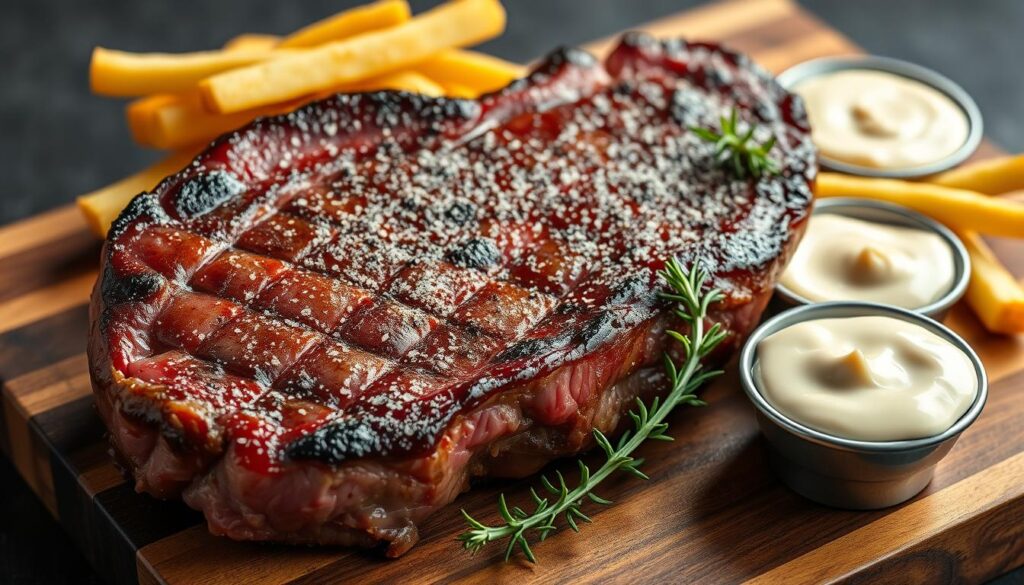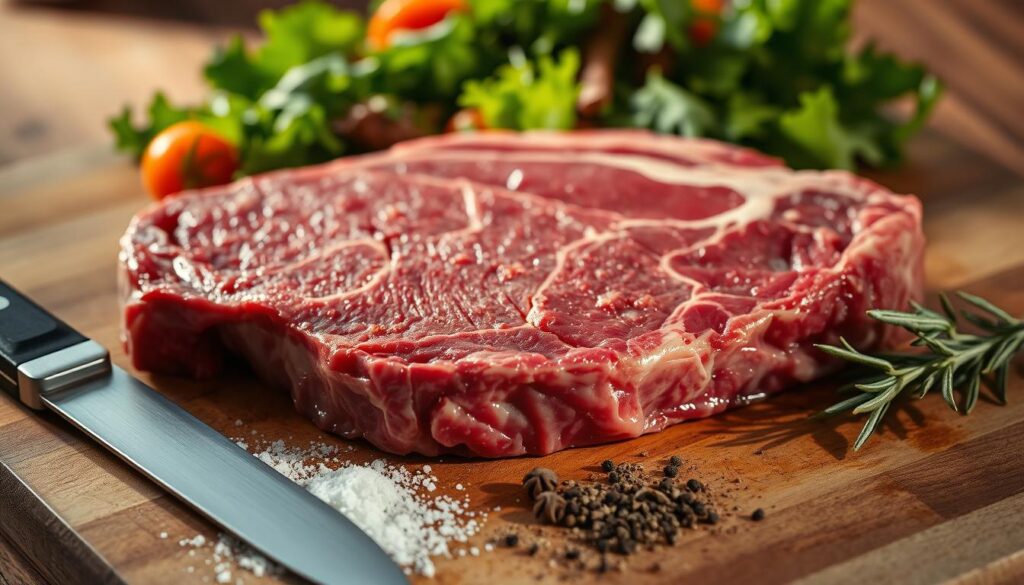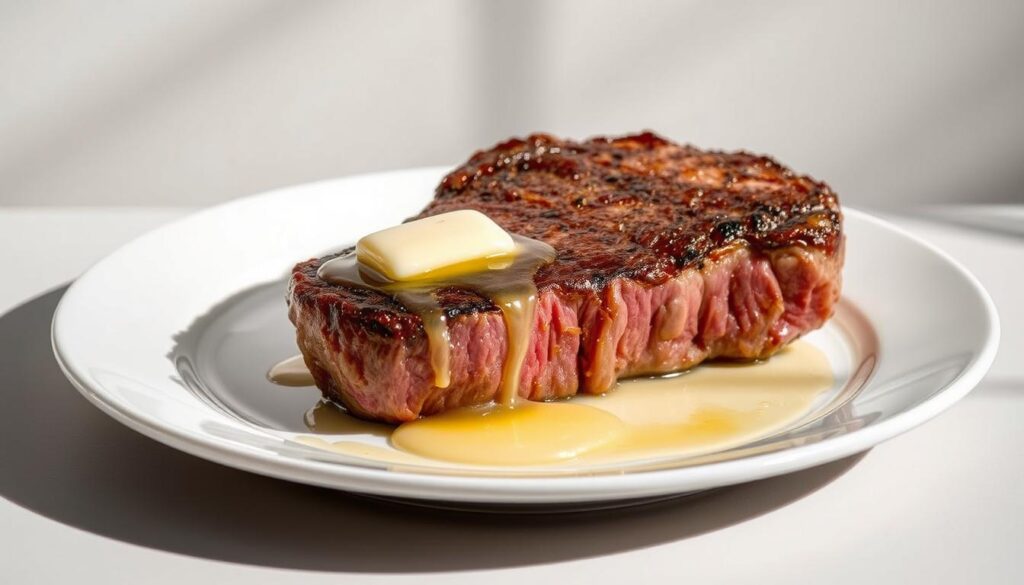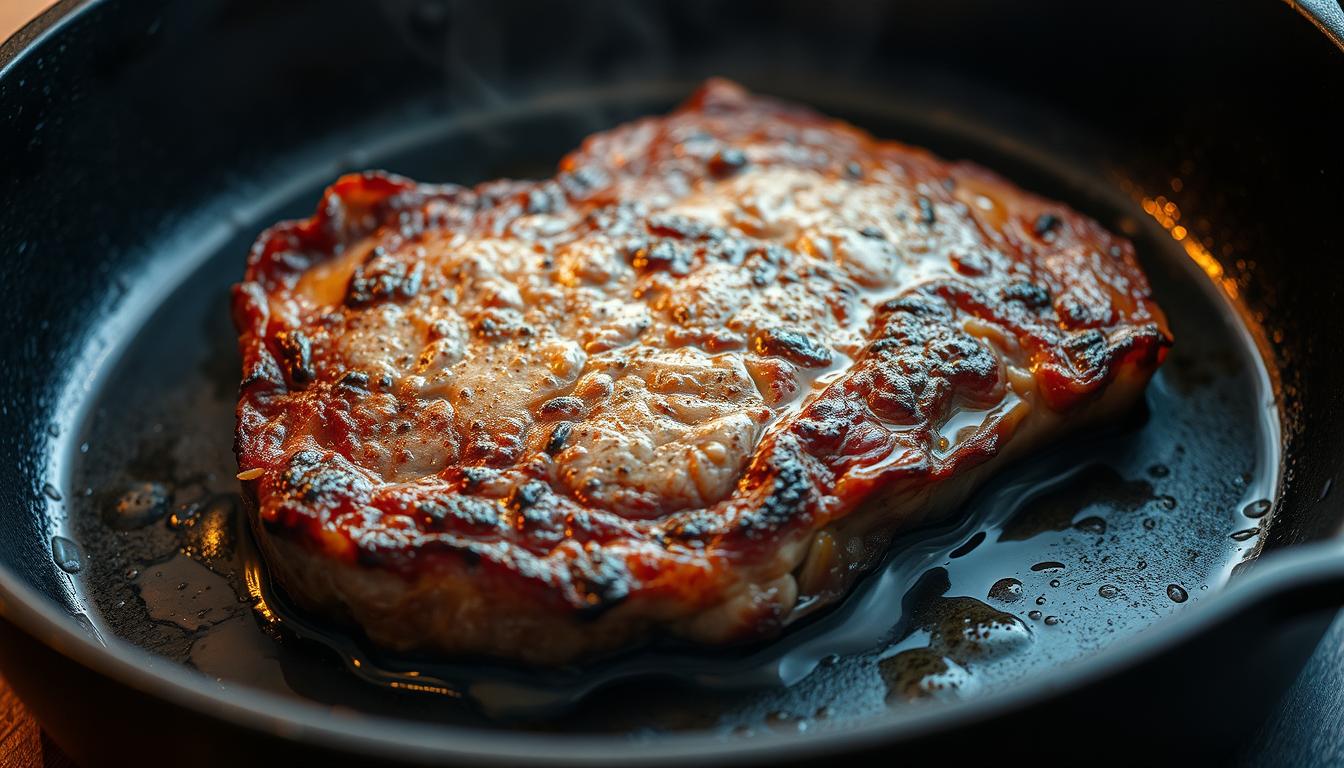Imagine sinking your teeth into a perfectly cooked T-Bone steak, the sizzle of a cast iron sear, and the rich flavors that only a home-cooked meal can deliver. Whether you’re a seasoned chef or a kitchen newbie, this guide will walk you through crafting a restaurant-quality T-Bone steak in the comfort of your own home.
There’s something special about a T-Bone steak. It’s not just a meal; it’s an experience. The combination of tender filet mignon and savory strip loin offers a delightful contrast of textures and flavors that steak lovers adore. With a cast iron skillet, you can achieve that elusive, crispy crust that elevates your steak game.
Cooking a T-Bone steak at home doesn’t have to be intimidating. This recipe is designed to be straightforward, focusing on simple techniques that yield impressive results. By following these steps, you’ll be able to enjoy a steakhouse experience without ever leaving your kitchen.
Key Takeaways
- Achieve a perfect sear with a cast iron skillet for restaurant-quality results.
- Simple techniques make cooking a T-Bone steak accessible to everyone.
- Home-cooked steaks can rival those served in high-end restaurants.
- The right thickness and marbling ensure a juicy, flavorful steak.
- A well-timed sear and proper resting period are key to a perfect finish.
Introduction: The Ultimate T-Bone Steak Experience
There’s something extraordinary about a home-cooked T-Bone steak. It’s more than just a meal—it’s an experience that combines flavor, texture, and technique. The sizzle of a perfectly seared steak, the aroma that fills your kitchen, and the satisfaction of achieving restaurant-quality results at home are what make this dish so special.
Why Home-Cooked Steak Excites Us
Cooking a T-Bone steak at home has become a thrilling adventure for many. The excitement lies in mastering the perfect sear, which locks in juices and flavors. It’s about the minute details—like the right heat and the precise timing—that make all the difference. The bone in the T-Bone adds a unique dimension, enhancing both moisture and taste. Each side of the steak cooks differently, creating a visually appealing dish with varied textures and flavors.
The Rise of Restaurant-Quality Recipes at Home
With the rise of home cooking, achieving restaurant-quality results has never been more accessible. The T-Bone’s structure, featuring both a strip loin and a tenderloin, offers a dual experience. Managing the heat and understanding the cut are crucial for bringing out the best in your steak. Whether you’re searing it in a skillet or finishing it in the oven, the key is in the technique.
| Feature | Importance |
|---|---|
| Proper Sear | Locks in flavor and moisture |
| Heat Management | Ensures even cooking and caramelization |
| Resting Time | Allows juices to redistribute |
The combination of these elements creates a steak experience that’s hard to match. Whether you’re a novice or an experienced cook, the T-Bone steak offers a rewarding challenge that delivers delicious results every time.
Why T-Bone Steak Stands Out
A perfectly cooked T-Bone steak offers an unmatched dining experience. This cut combines the tender filet mignon and the robust strip loin, creating a delightful contrast of flavors and textures that captivate steak enthusiasts.
Understanding the T-Bone Cut
The T-Bone steak is a composite of two prized cuts: the strip loin and the tenderloin. The strip loin, known for its rich flavor and firm texture, is complemented by the tenderloin’s buttery softness. This dual composition makes the T-Bone a unique and satisfying choice.
The quality of the meat is paramount. A well-marbled T-Bone ensures juiciness and depth of flavor. Each bite benefits from the even distribution of fat, enhancing the overall taste experience.
To achieve a crisp crust, preheating the pan with a small amount of oil is essential. A hot pan sears the steak instantly, locking in juices. Generously seasoning with salt before cooking brings out the natural flavors of the meat.
Maintaining the right temperature is crucial. Whether searing in a pan or finishing in the oven, precise control ensures the steak cooks evenly. Use a thermometer to monitor the internal temperature, aiming for medium-rare at 130–135°F for optimal tenderness.
Enhance the natural flavors with herbs like rosemary or thyme. These herbs add a subtle yet aromatic depth without overwhelming the steak’s inherent taste. Drizzle with olive oil before serving for a finishing touch.
The perfect steak balances a beautifully seared exterior with a juicy interior. By mastering the sear and allowing the steak to rest, you achieve a dish that’s both visually appealing and deliciously satisfying.
Best 5 T Bone Steak Recipe Essentials
Creating a memorable T-Bone steak dish starts with the right ingredients and techniques. Essential components include high-quality strip loin and tenderloin, fresh herbs like rosemary, and unsalted butter for basting.
Seasoning plays a crucial role in enhancing flavor. Generously apply salt and pepper, allowing the steak to sit for 45 minutes before cooking. Some recipes incorporate Italian seasonings like thyme and oregano for added depth. The New York strip approach, focusing on even searing, is often applied to T-Bone recipes for consistent results.

Butter basting is a game-changer, adding moisture and richness. Melted butter infused with garlic or herbs drizzled over the steak during cooking locks in flavor. A well-heated skillet ensures a perfect sear, crucial for retaining juices and achieving that crispy crust.
Combining these elements—quality ingredients, precise seasoning, and expert techniques—elevates your T-Bone steak to new heights. Whether you’re a novice or a seasoned cook, these essentials guarantee a delicious, restaurant-quality meal at home.
Ingredient Breakdown and Pre-Cooking Tips
Preparing a delicious T-Bone steak begins with the right ingredients and proper preparation. Let’s break down what you need and how to get your steak ready for cooking.
Selecting the Perfect Cut and Marbling
A great T-Bone steak starts with the right cut. Look for beef with good marbling, as this ensures juiciness and flavor. The steak should be at least inch thick to cook evenly and stay tender. When choosing, assess the marbling—small flecks of fat throughout the meat are ideal for a rich taste experience.
Prepping Your Steak: Temperature and Seasoning Basics
Before cooking, let the steak sit at room temperature for about 45 time. Pat it dry with paper towels to remove excess moisture. Generously season with pepper and a touch of garlic for added depth. Allow the steak to sit for another 30 minutes to let the seasonings infuse into the meat.
| Ingredient | Quantity | Purpose |
|---|---|---|
| Oil | 1 tablespoon | For searing |
| Salt | To taste | Enhances flavor |
| Pepper | Generous sprinkle | Seasoning |
| Garlic | 1 clove, minced | Flavor enhancement |

Using a tablespoon of oil in a hot skillet ensures a perfect sear. This step is crucial for locking in juices and achieving that crispy crust. Remember, the key to a great steak is balance—let the natural flavors of the beef shine while enhancing them with your seasonings.
Step-by-Step Cooking Process
Cooking a T-Bone steak to perfection involves a few simple steps that ensure a flavorful and tender result. By following these steps, you can achieve a restaurant-quality finish in the comfort of your own kitchen.
Searing for a Caramelized Crust
The first step is searing the steak over high heat to create a caramelized crust. Preheat a cast iron skillet over high heat for 5 minutes. Lightly oil the pan and place the steak, searing for 2-3 minutes per side. This step locks in juices and creates a golden-brown crust.
Finishing in the Oven or on the Grill
After searing, transfer the steak to a preheated oven at 415°F or finish it on the grill. For medium-rare, cook for 4-5 minutes in the oven or 5-10 minutes on low heat on the grill. This ensures even cooking throughout the steak.
The Art of Letting the Steak Rest
Once cooked, let the steak rest for 5-7 minutes. This allows the juices to redistribute, making the steak more tender and juicy. Patience here is key to achieving the best flavor and texture.
| Step | Action | Time |
|---|---|---|
| 1 | Sear in cast iron skillet | 2-3 minutes per side |
| 2 | Finish in oven or grill | 4-5 minutes (oven) or 5-10 minutes (grill) |
| 3 | Let steak rest | 5-7 minutes |

Expert Techniques for Flavor and Texture
Elevating your T-Bone steak to new heights involves mastering a few expert techniques that enhance both flavor and texture. From seasoning strategies to butter basting, these methods ensure a memorable dining experience.
Seasoning Strategies: Salt, Pepper, and Italian Herbs
Professional chefs emphasize the importance of proper seasoning. Start by generously sprinkling salt and freshly ground pepper on both sides of the steak. Allow it to sit for about 45 minutes to let the seasonings infuse into the meat. For added depth, incorporate Italian herbs like thyme or rosemary. These herbs complement the natural flavors of the tenderloin without overpowering it.
Butter Basting and Herb Infusion Tips
Butter basting is a game-changer for adding moisture and rich flavor. Melt unsalted butter and mix in minced herbs like parsley or chives. Drizzle this mixture over the steak during the last few minutes of cooking. This technique not only enhances the steak’s juiciness but also adds a layered, aromatic flavor profile.
| Feature | T-Bone | Porterhouse |
|---|---|---|
| Size | Smaller cut | Larger cut |
| Components | Strip loin and tenderloin | Strip loin, tenderloin, and more bone |
| When to Use | For a balanced meal | For a hearty, indulgent dish |
Achieving medium-rare doneness is key for optimal texture. Use a thermometer to ensure the internal temperature reaches 130–135°F. After cooking, let the steak rest for 5–7 minutes to allow juices to redistribute, making the meat tender and juicy. Handling the fatty portions with care ensures even cooking and prevents flare-ups, especially when grilling.

Serving Suggestions and Accompaniments
Transform your T-Bone steak into a memorable dining experience with the right sides and presentation. Whether you’re aiming for a cozy family dinner or an elegant gathering, these ideas will elevate your meal.
Perfect Side Dishes to Complement the Steak
Pair your T-Bone with classic sides that enhance its rich flavor. Mashed potatoes, roasted asparagus, or steamed vegetables are timeless choices. For a more indulgent option, consider twice-baked potatoes with cheese and bacon or creamy mac and cheese.
- Mashed Potatoes: Creamy and comforting, they soak up the steak’s juices perfectly.
- Roasted Asparagus: A light, flavorful option that balances the meal.
- Steamed Vegetables: Simple yet vibrant, offering a refreshing contrast.
Plating and Presentation Ideas
Make your dish visually appealing. Use a clean, elegant plate and garnish with fresh herbs like rosemary or thyme. Slice the steak against the grain for tenderness and arrange it attractively alongside your chosen sides.
- Slice Against the Grain: Ensures each bite is tender and juicy.
- Garnish with Herbs: Adds color and fragrance to the plate.
Let the steak rest for 5-7 minutes before slicing to redistribute juices. Use a thermometer to ensure the perfect doneness—aim for 130–135°F for medium-rare. A good sear on the loin portion locks in flavors, making each bite unforgettable.
Conclusion
Cooking a delicious T-Bone steak at home is simpler than you might think. With a few essential techniques and attention to detail, you can achieve restaurant-quality results without leaving your kitchen. The key steps include seasoning generously, searing at high heat, and allowing the steak to rest properly. These simple practices ensure a juicy and flavorful outcome every time.
Remember, the success of your T-Bone steak lies in the balance of flavors and textures. Don’t be afraid to experiment with different seasonings and herbs to find your perfect combination. Proper resting time and slicing against the grain will make each bite tender and enjoyable. Presentation matters too—so take a moment to arrange your dish attractively and garnish with fresh herbs for that finishing touch.
We’d love to hear about your experiences with this recipe! Share your tips, favorite sides, or any variations you’ve tried. Whether you’re a seasoned cook or just starting out, your feedback helps us all enjoy better meals together. Happy cooking!


